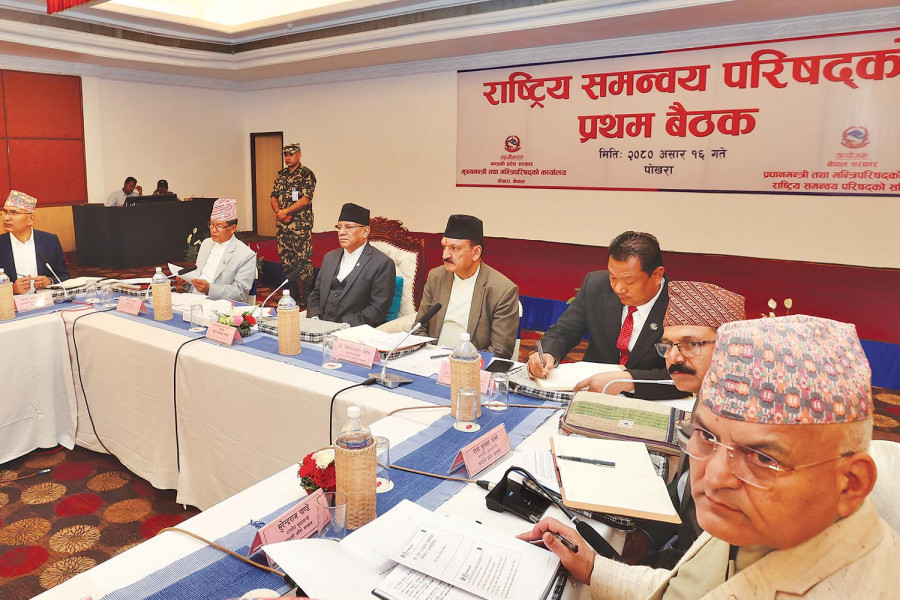Columns
So many entities, so little work
There are many intergovernmental bodies, but their impact appears to be negligible.
Khim Lal Devkota
In June 2022, Members of Parliament from both the ruling and opposition parties presented a resolution proposal on implementing federalism in the National Assembly. The proposal encompassed 15 key points related to federalism implementation. The National Assembly unanimously endorsed the proposal and directed the government to implement it.
Subsequently, in October 2022, a cabinet meeting endorsed a roadmap for implementing this federalism resolution. However, it is noteworthy that, to date, the government has not shown serious commitment to follow it. Even the instructions issued by Parliament and the government's own action plan remain unimplemented. This raises the question: What could be more disheartening or disappointing than this?
The resolution proposal encompasses several sectoral areas. Among them, the first provision, the "activation of intergovernmental relations institutions", holds particular significance. As one of the proposers of the resolution, I have been asked by parliamentarians and media professionals what it means. In today's piece, I delve into the theoretical significance of intergovernmental relations (IGR), and connect this theoretical perspective to our federalism context.
Lifeblood of federalism
In a book entitled Intergovernmental Relations in Federal Systems (2015) published by the Forum of Federations, editors Johanne Poirier and Cheryl Saunders assert emphatically, "IGR stands as the lifeblood of federalism itself, an integral and indispensable component within every federal system, much like the lubricant that ensures smooth operation, or the friction that sparks dynamism in the federal machine."
Continuing to draw from Poirier and Saunders' perspective, in political science literature, IGR is often viewed through the lens of power dynamics and negotiations, where the legal and political party system typically plays a limited role. In reality, the role of IGR extends beyond party politics. For instance, the first time Nepal's chief ministers convened a meeting in Pokhara in September 2018, they raised a collective voice against the federal government. This gathering took place despite instructions by their own party's prime minister.
In an article titled "Big Questions about Intergovernmental Relations and Management: Who Will Address Them?" (2011) published in the American journal Public Administration Review, Kincaid and Stenberg provide a comprehensive definition of intergovernmental relations. They state, "Intergovernmental relations is a comprehensive term that encompasses a wide range of interactions between elected and non-elected officials across various levels of government, including federal, state, and local. A critical facet of IGR lies in its association with policy-making, encompassing both the legislative processes and the formulation of regulations. In this arena, elected officials and agency heads play pivotal roles as significant actors within the framework of intergovernmental relations."
A paper entitled "Conclusion to Intergovernmental Relations in Federal Countries" by Richard Simeon has been published on the Forum of Federations webpage. In this paper, the author analyses case studies from eight federal countries: Argentina, Australia, Brazil, Canada, Germany, Russia, South Africa and the United States. The conclusion drawn from the studies is that "the experience of other countries described in this set of studies suggests numerous opportunities for cross-national learning, providing a valuable foundation for evaluating and enhancing one's own institutions and practices."
Following the aforementioned paragraphs, it's essential to acknowledge that each country has its unique characteristics and experiences, making it clear that a one-size-fits-all model cannot be applied. However, as Richard Simeon aptly points out, the initial step is to engage in learning and gaining experience and subsequently adapt these insights to the context of one's own country if deemed suitable.
These definitions reveal that the institutionalisation of the federal system necessitates regular dialogue and discussion between government levels. Such dialogues and discussions occur through both formal and informal channels.
Regarding Nepal, the constitution recognises the provision for IGR. It also outlines a theoretical framework and introduces a key institution, the Interprovincial Council.
The constitution is unequivocal regarding intergovernmental relations, emphasising that the relationship between the federal, provincial and local levels must be built upon the principles of cooperation, coexistence and coordination (Article 232). Article 234 establishes an Interprovincial Council, chaired by the prime minister, to address political disputes that may arise between the federation and the provinces or among the provinces.
In December 2018, an Interprovincial Council meeting under the prime minister's chairmanship endorsed a “29-point federalism implementation road map”. Unfortunately, less than half of these points have been executed. The successful implementation of federalism largely depends on the continuous convening of this council's meetings and the subsequent execution of decisions. Regrettably, the council has not convened a meeting in four years. Hence, the resolution proposal includes activating the Interprovincial Council and other IGR entities.
To enhance the effectiveness of intergovernmental relations, the Coordination and Interrelation Act of 2020 has also been issued. This law establishes a high-level coordination institution known as the National Coordination Council with the prime minister as its chair. Three years after the law was enacted, the council convened a meeting in Pokhara on July 1, 2023, during which significant decisions were made. However, there appears to be lack of commitment to implement these decisions. For instance, the meeting's decisions include eliminating redundant institutional structures, but paradoxically, the government has presented bills in Parliament to resurrect these defunct institutions, as shown by the Education Bill that seeks to revive the District Education Office and the Education Department.
Ineffective and dormant
The coordination law also provides for Provincial Coordination Councils, chaired by the chief minister. This entity is pivotal in facilitating coordination between the provinces and the local levels.
The law has established ministerial-level sectoral committees, but it appears they are largely ineffective and remain dormant. Furthermore, the Intergovernmental Fiscal Arrangement Act of 2017 includes the provision of an Intergovernmental Fiscal Council to be led by the finance minister. Regrettably, this council has failed to exhibit the expected level of activity.
To function effectively as an Intergovernmental Relations (IGR) body, our constitution also includes the National Natural Resources and Fiscal Commission and the District Coordination Committee. Unfortunately, the role of the former has been significantly constrained by legal provisions, and its proactivity is lacking. Meanwhile, the District Coordination Committee is beset by inefficiencies and ineffectiveness.
This has placed us in a situation where we possess numerous IGR bodies, but their impact appears negligible. In stark contrast, several federal countries, such as the US, Canada, Australia and Brazil do not rely on such formal IGR bodies. Instead, they have robust informal mechanisms for intergovernmental relations. Hence, the focus should shift from creating additional institutions to streamlining and enhancing the functionality of the existing ones instead.




 16.12°C Kathmandu
16.12°C Kathmandu















